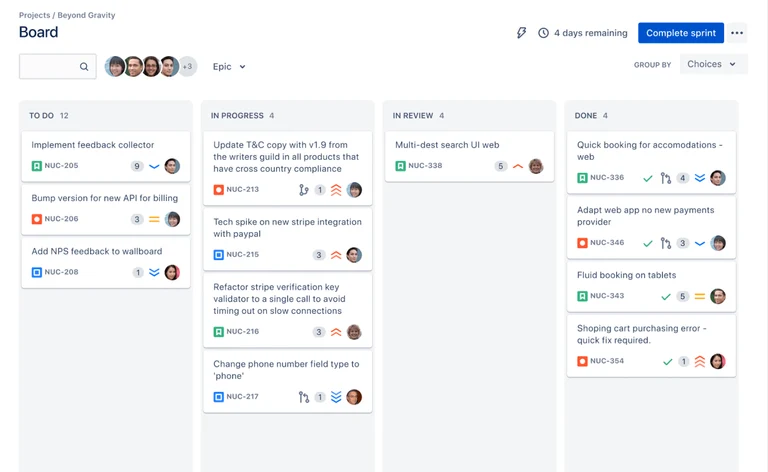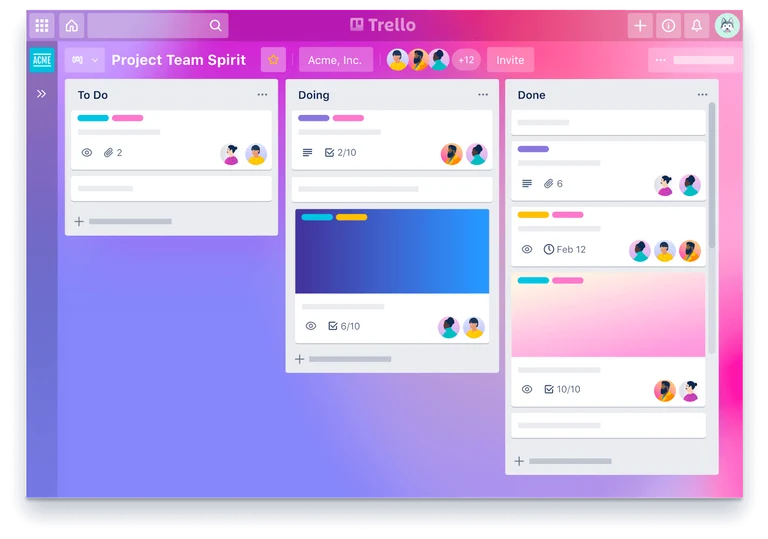Jira vs. Trello: Atlassian’s Project Management Tools
Agile has become a buzzword and a trend in software and web development in the last few years. However, in the context of project management, agile is still a specific methodology that advocates for developing software in phases by constantly collaborating with various stakeholders and continuously improving at every stage.
Agile project management is still the key to satisfying customers, improving software quality, reducing risks, being adaptable, predictable, and more. It can be applied not just to software development and product but to marketing, creative, and many other areas of business.
The best way to apply the agile project management methodology to your projects is by using agile-specific project management tools. In your search for the perfect tool to do that, you’ve probably come across Jira and Trello. Both are very popular, have a similar audience, and are owned by Atlassian. Choosing between the two can be challenging, so in this post, we’ll compare the two, primarily their agile features.
Jira and Trello Overview
Before we dive into comparing their specific features, let’s take a step back and get an overview of both tools. Jira and Trello are project management tools designed for managing tasks and projects by either one person or a team of people. As previously mentioned, both are owned by Atlassian, as the company purchased Trello in 2017, almost two decades after they launched Jira.
One of the main reasons why Jira and Trello are popular is because of how users can visualize their tasks. Both have Kanban boards — a visualization tool that enables teams to optimize their workflow and be more focused, visible, and productive.
Jira is a complex tool that supports other types of agile boards, making it an excellent choice for complex tracking systems and for teams that need more comprehensive support with implementing agile methodology, a trait prevalent in software development project management.

On the other hand, Trello is a more straightforward tool that can be learned quickly. It works great for more general-purpose tasks, not just ones that are part of the PDLC.
3 Essential Features of Jira and Trello
Now that we know more about Jira and Trello, let’s explore and compare the essential features for managing any agile-based project.
Boards and Agile Methodologies
Probably the two most important sets of features, both tools provide them in some capacity. However, there are differences.
Jira
When directly comparing Jira and Trello, Jira has more features specific to agile boards and related methodologies. In addition to Kanban boards, Jira also has Scrum boards — ideal for teams that plan their work in multiple sprints.
In addition to Kanban and Scrum boards, Jira also offers Roadmaps — a helpful feature for planning more complex work weeks or months in advance. The roadmaps feature also allows teams to release new or improved product versions more predictably while staying on target and achieving their goals.
Regarding methodologies, Jira supports Agile, Scrum, and others. The tool also allows users to generate reports based on a picked methodology, which ensures that the team stays on the right track.
Speaking of Scrum, Jira also allows its users to create multiple sprints in a project and have separate boards for each sprint, which allows for even deeper sprint planning and organization of the project and the team.
Trello
Trello takes a more straightforward approach. The tool features a simple but customizable Kanban board (called Trello Board) view. Users can add an unlimited number of columns and customize their names. It also works simply — users can drag tasks between different columns, making it easy to move tasks from one stage to another while keeping them in sight.
In addition to the Trello Boards view, users can also see their tasks in a timeline, calendar, or map view. While Trello doesn’t have a native roadmaps feature, they have a Product Roadmap Template users can download and use in their Trello Boards.
Trello doesn’t include agile reporting features, and Trello Boards can’t track multiple sprints over time, making it hard to follow Scrum or a different agile methodology strictly.
Backlog
An agile backlog makes it easy to plan iterations and releases and broadcasts everything the team is working on, making it easier to set expectations with stakeholders and other teams.
Jira
Jira offers a total backlogging solution. The software can store multiple tasks in a to-do list view, and the user can import these tasks into sprint boards later.
Trello
Right now, Trello doesn’t have a backlog feature per se. Users can manually set one up by creating a column titled “Backlog” in their existing Trello Board and using it for storing all of the tasks that will be planned and assigned later on.

Task Planning
In an agile project, people break the features they’re developing into tasks and then work on them. Planning tasks helps reduce uncertainty and enables the successful completion of tasks.
Jira
Atlassian built Jira with task planning in its foundations. The project management platform allows its users to quickly sort tasks in the backlog based on points, then calculate the capacity of the team based on the amount of work in each sprint. This makes it easier to plan more complex software development projects.
Trello
Trello doesn’t have any task-planning features out of the box. However, users can use custom fields for planning sprints.
Other Things to Consider
In addition to agile-specific features, both tools offer a bunch of other features, integrations, and considerations that might sway you in one direction.
Integrations & Automation
Both Jira and Trello integrate with other platforms and full API access, allowing you to create your custom project and task management workflows. In addition to integrations, both platforms provide automation abilities.
Trello, in the tool Butler, allows users to stitch together various commands and execute them on tasks and boards. Jira has a rules-based automation tool that will enable users to automate tasks and boards.
Availability
Both Jira and Trello are available through first-party web apps. Jira also has iOS and Android apps, while Trello is available on a few more platforms — iOS, Android, macOS, and Windows.
Pricing
Jira offers a free plan for up to 10 users on a single site. The free plan includes several features, including Kanban and Scrum boards, backlog organization, agile reporting, integrations, and more.
Jira paid plans start at $7.75 to $15.25 per user per month. The paid plans allow up to 20,000 users, more administrator controls, data compliance processes, multi-project automation, advanced dependency management features, and more. Trello also has a free version. It features unlimited items across 10 boards, assignees, due dates, and more.
Trello’s prices start at $6 to $17.50 per user per month and include advanced checklist options, custom fields, dashboard view, timeline view, better admin and security control, Google SSO, and more.
Which Tool Should You Choose?
Jira is a great project management tool for agile teams and companies that want to build and release software by the book.
Trello is a simple and customizable Kanban board tool for agile teams that want to follow an agile methodology but don’t want to adhere to all agile development rules strictly.
At the end of the day, your answer to this question and your choice of tool will likely depend on the specific needs of your projects and how you want to manage them.
FAQs:
Q1. Which is better, Trello or Jira?
Jira has more features on paper, but Trello is more flexible – and so answering this question is quite tricky. Ultimately, the answer depends on the projects you’re planning on managing, and what is better for you.
Q2. Why does Atlassian have Trello and Jira?
Atlassian bought Trello because the two companies have similar goals and a common understanding. By combining their forces, Trello and Atlassian are better positioned to dominate a crowded market, according to Mike Cannon-Brookes, the co-founder and co-CEO of Atlassian.
Q3. What are the disadvantages of Jira?
Jira can be difficult to set up and use. Their UI is complex, which makes it harder to manage tasks. There isn't a built-in timeline to track project progress, and it can get pretty expensive, according to one of their competitors, ClickUp.
